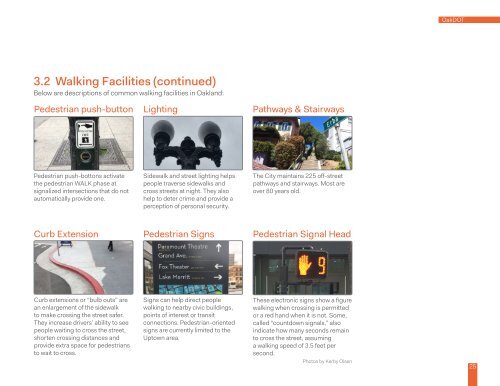Oakland Walks!
oak063431
oak063431
You also want an ePaper? Increase the reach of your titles
YUMPU automatically turns print PDFs into web optimized ePapers that Google loves.
OakDOT<br />
3.2 Walking Facilities (continued)<br />
Below are descriptions of common walking facilities in <strong>Oakland</strong>:<br />
Pedestrian push-button<br />
Lighting<br />
Pathways & Stairways<br />
Pedestrian push-bottons activate<br />
the pedestrian WALK phase at<br />
signalized intersections that do not<br />
automatically provide one.<br />
Sidewalk and street lighting helps<br />
people traverse sidewalks and<br />
cross streets at night. They also<br />
help to deter crime and provide a<br />
perception of personal security.<br />
The City maintains 225 off-street<br />
pathways and stairways. Most are<br />
over 80 years old.<br />
Curb Extension<br />
Pedestrian Signs<br />
Pedestrian Signal Head<br />
Curb extensions or “bulb outs” are<br />
an enlargement of the sidewalk<br />
to make crossing the street safer.<br />
They increase drivers’ ability to see<br />
people waiting to cross the street,<br />
shorten crossing distances and<br />
provide extra space for pedestrians<br />
to wait to cross.<br />
Signs can help direct people<br />
walking to nearby civic buildings,<br />
points of interest or transit<br />
connections. Pedestrian-oriented<br />
signs are currently limited to the<br />
Uptown area.<br />
These electronic signs show a figure<br />
walking when crossing is permitted<br />
or a red hand when it is not. Some,<br />
called “countdown signals,” also<br />
indicate how many seconds remain<br />
to cross the street, assuming<br />
a walking speed of 3.5 feet per<br />
second.<br />
Photos by Kerby Olsen<br />
25


